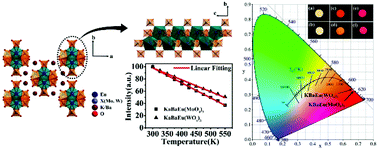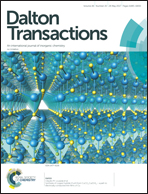Novel red phosphors KBaEu(XO4)3 (X = Mo, W) show high color purity and high thermostability from a disordered chained structure†
Abstract
Two novel red phosphors KBaEu(XO4)3 (X = Mo, W) have been synthesized by high-temperature solid-state reactions and the crystal structures were determined for the first time. Single-crystal X-ray diffraction data reveal that their space groups are C2/c. The crystalline structure is constituted of K/BaO8 distorted square antiprisms and distorted EuO8 polyhedra which form chains lying along the c-axis and two kinds of distorted XO4 tetrahedra. This high disorder of K/Ba which might lower the crystal field symmetry around Eu3+ results in the high purity of red emission around 615 nm originating from 5D0 → 7F2 transition under near-ultraviolet (NUV) excitation. With increasing temperature, the luminescence of KBaEu(XO4)3 (X = Mo, W) phosphors decreases almost linearly with subtle alteration for the CIE coordinate. As the temperature reaches 550 K, the red emission intensity decreases to 37.3% and 50.7% of that at 300 K for KBaEu(MoO4)3 and KBaEu(WO4)3, respectively. The analysis of the decay curves of the 5D0 → 7F2 emission at variable temperatures indicates the weak cross relaxation and non-radiative energy transfer between Eu3+ ions. These results demonstrate that the investigated phosphors are attractive for application in high power NUV excited white LEDs.



 Please wait while we load your content...
Please wait while we load your content...